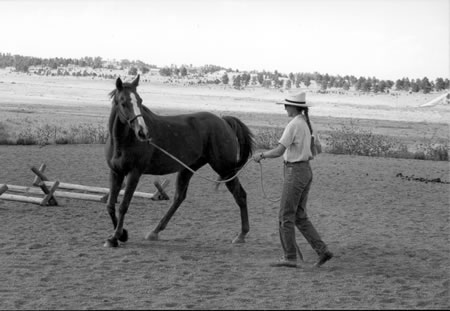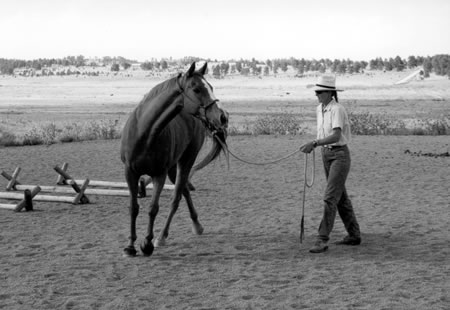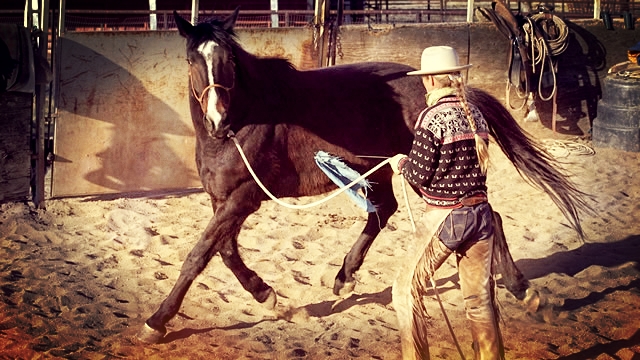With Mindy Bower
A simple thing that many people miss
Situation:
When I first watched Ginsor’s owner work him on the ground, the first word that came to mind was “sloggy.” While this is not a real word, it carried the feeling of what I was seeing. His owner was having a very difficult time getting him to drive past her, he was moving so slow. Now, Ginsor is a very lanky, bendable horse, so he is able to have his body going in many different directions at the same time. The situation was exacerbated by the fact that what little life he had was being lost because it was heading in separate ways.
As she asked him to travel in a circle around her, Ginsor’s hips would fall to the inside of the circle and his shoul- ders fell to the outside. His neck was disconnected from the rest of his body. To his owner, it seemed that he was doing the correct thing: he was moving in a circle around her. But, his body was not aligned, and therefore, he could not push with his hind legs.
Once she started to ride, it was apparent to me that this unconnected- ness carried over to the saddle. She could not get him to go straight. He would run out on jumps and he would get totally discombobulated. Ginsor was not pushing evenly with both hind legs, and this was very troublesome to him.

My goals were not only to get Ginsor lined up in his body and travel- ing around the circle with life, but to teach his owner to be able to see for her- self when he was moving properly and when he was falling in or out of the circle.
We started at the beginning. First we worked on how Ginsor initated for- ward movement, and then improved how he carried that movement around a circle.
Of course, this was easier said than done.

Exercise:
Ask your horse to drive around you; evaluate how well he starts off and travels around the circle.
Benefits:
• Discover how halterbroke your horse is. When you ask your horse to lead for- ward and come off of pressure from the halter, if there is a hesitation then he is not as well halterbroke as he could be. Your horse should lead at the slightest suggestion. If he cannot, then that lag will carry over when he is ridden.
• Soothe a worried horse. Some horses can get very upset if they are not using their hindquarters properly, resulting in many symptoms ranging from bucking to irritation to being nervous or upset. If your horse is having these troubles, use this exercise to evaluate and perhaps pinpoint where the problems started.
• Build a straight foundation. If your horse can travel around the circle with impulsion and straightness, it will carry over to the work that you ask him to do under saddle. If your horse is straight, then he can use his hind legs evenly, giv- ing him more push from behind and to help him to develop properly.
• Increase your awareness of your horse’s body. Unless you are really look- ing and evaluating your horse, it is easy to miss areas where he might be sticky or crooked. You might see that your horse is traveling past you in a circle but not see that he is falling in or out or that he is not bending through his body around a circle.
 Is your horse on track? A good visual to keep in mind while driving your horse around you in a circle.
Is your horse on track? A good visual to keep in mind while driving your horse around you in a circle.
How to do it:
1. Start by asking your horse to lead past you going to the left. Ask by lifting your left hand out and forward in front of your horse. If your horse leads off straight forward with no hesitation, con- gratulations, you have a well halter broke horse. If there is any lag or heavi- ness, you have a little project to work on.
2. If your horse does not lead for- ward just from the suggestion of your leading hand, then you will follow up with your driving hand. In this case it is your right hand. Start by making contact with your leading hand. This is the good deal that you are offering your horse. If he does not respond, swing the tail of the rope overhand toward your horse’s hindquarters. Keep your left hand out, directing your horse forward. If your horse does not respond, you might need to tap him with the tail of the rope. Start softly, and increase until your horse moves forward. Once he goes forward and puts slack in the rope between his head and your leading hand, then stop your driving hand. That’s what you’re looking for.
3. Let your horse stop. Start again. Offer a good deal with your leading hand, and follow up with your driving hand if he does not respond. Keep working on this piece until your horse leads forward with life from just a sug- gestion with your leading hand.
4. Once the start is solid, evaluate how well your horse is traveling around the circle. Check his straightness by asking him to speed up to a faster walk or even a trot. If he can keep together and make a transition without wanting to fall in or out or pull back, then he is most likely pushing evenly with both hind legs and tracking around the circle. If he does not, then you have another project to work on.
5. As your horse walks around you in a small circle to the left, your left hand should be extended out to your left. When your horse is moving as you would like him to, there should be slack between your leading hand and his head. Ask him to speed up by making contact with your leading hand. Ask him to lead forward around the circle. If he does not, again, use your right hand to drive him forward until he puts slack in the rope and tracks around the circle.
6. Experiment with starting your horse from a stop and moving to a walk. Once that feels good, work on the tran- sition from the walk to a faster walk, or up to the trot. Be clear and consistent with how you ask, and your horse will soon learn to follow the feel of your leading hand. Being able to ride your horse anywhere that you would like begins first with being able to lead your horse how you would like.
What to watch for as you work:

As you are doing the ground- work, asking your horse to travel around you in a cir- cle, observe how your horse moves. Are his hindquarters tracking up and pushing from behind? What hap- pens if you ask him to speed up while staying on that small circle? Does he want to pull away from you, or fall into you, or pull back? Or does he push with his hindquarters and stay on track around the circle?
For very compact horses this exercise is usually much easier. For big, gangly, stretchy horses like Ginsor this is much more difficult.
When you are working on the circle, imagine that there are circular train tracks around you. You are standing in the middle of them and your horse is traveling in between the two rail lines. His inside hind leg foot should be lined up with his outside front foot.
If he is tracking properly, evenly around the circle he will bend his body around the arc and stay between the rails. If he is falling out with his hindquarters or in with his front quar- ters or vice versa then he will be cross- ing over those imaginary rail lines with his body and will not be traveling on track. If he is pushing from behind evenly, the impulsion will carry him around the tracks.
How it worked out:
Once Ginsor got straight first on the ground and eventually in the saddle, he became quite relaxed and peaceful. Instead of sloggy, he was steady in his mind and through his body. Not every horse would have been as upset as he was, but for him it was very troubling. By working on the ground, he was able to have a starting point for pushing evenly with his hind legs and being able to travel straight.
The riding and the groundwork are interconnected. If you have a piece miss- ing on the ground, it will follow you into the saddle. By the same connection, you can get some good things working on the ground that will help you when you ride your horse as well.
This article originally appeared in Eclectic Horseman Issue No.2


